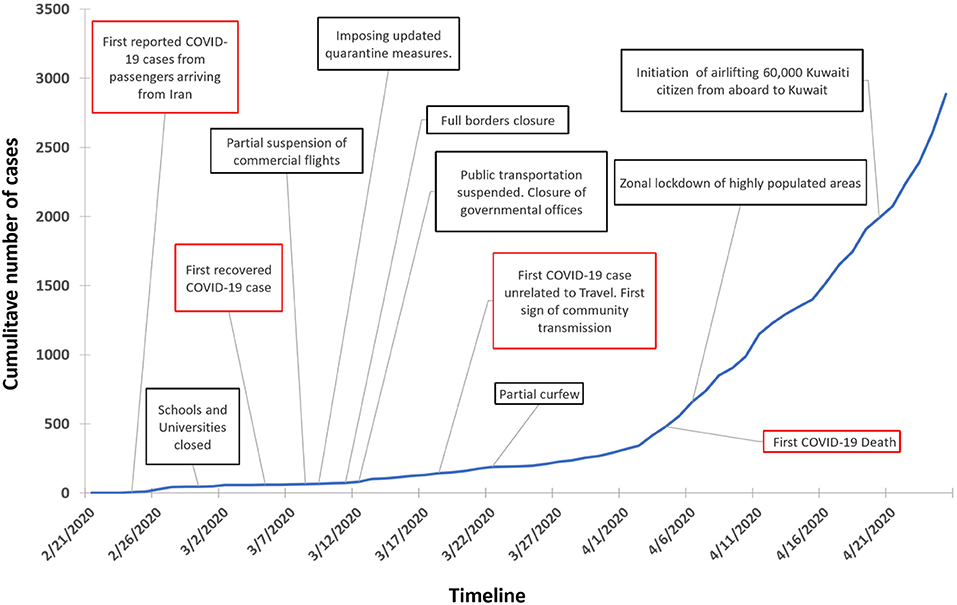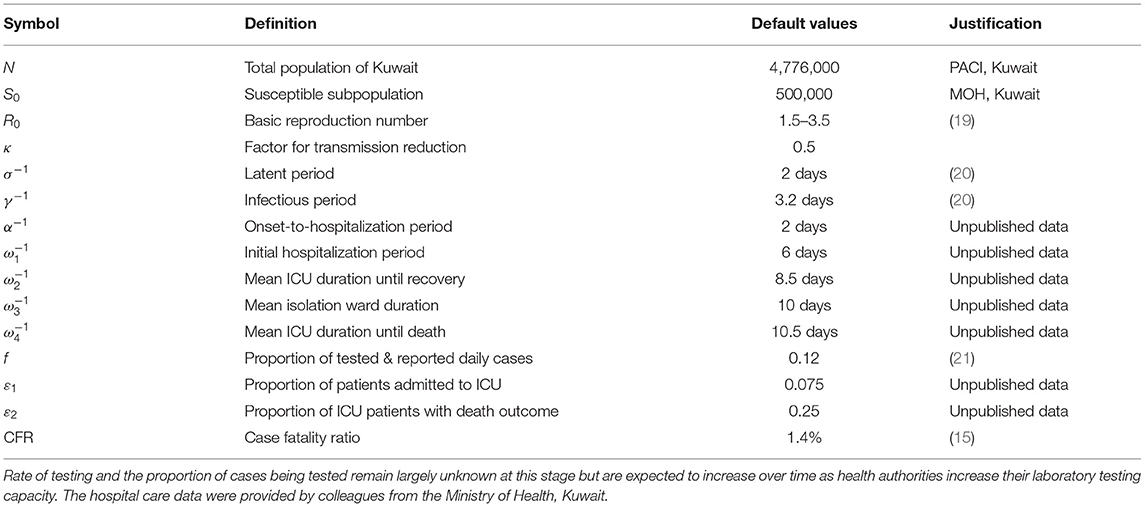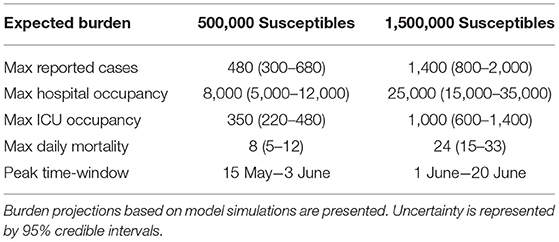- 1Department of Mathematics, Faculty of Sciences, Kuwait University, Kuwait City, Kuwait
- 2Dasman Diabetes Institute, Kuwait City, Kuwait
- 3Department of Medical Laboratory Sciences, Faculty of Allied Health Sciences, Health Sciences Center, Kuwait University, Kuwait City, Kuwait
- 4Department of Environmental Health, Harvard T. H. Chan School of Public Health, Harvard University, Boston, MA, United States
- 5Department of Surgery, Faculty of Medicine, Health Sciences Center, Kuwait University, Kuwait City, Kuwait
- 6Department of Surgery, Jaber Al-Ahmad Hospital, Ministry of Health, South Surra, Kuwait
- 7Department of Otolaryngology and Head and Neck Surgery, Jaber Al-Ahmad Hospital, Ministry of Health, South Surra, Kuwait
Background: Many countries have succeeded in curbing the initial outbreak of COVID-19 by imposing strict public health control measures. However, little is known about the effectiveness of such control measures in curbing the outbreak in developing countries. In this study, we seek to assess the impact of various outbreak control measures in Kuwait to gain more insight into the outbreak progression and the associated healthcare burden.
Methods: We use a SEIR mathematical model to simulate the first wave of the epidemic outbreak of COVID-19 in Kuwait with additional testing and hospitalization compartments. We calibrate our model by using a NBD observational framework for confirmed case and death counts. We simulate trajectories of model forecasts and assess the effectiveness of public health interventions by using maximum likelihood to estimate both the basic and effective reproduction numbers.
Results: Our results indicate that the early strict control measures had the effect of delaying the intensity of the outbreak but were unsuccessful in reducing the effective reproduction number below 1. Forecasted model trajectories suggest a need to expand the healthcare system capacity to cope with the associated epidemic burden of such ineffectiveness.
Conclusion: Strict public health interventions may not always lead to the same desired outcomes, particularly when population and demographic factors are not accounted for as in the case in some developing countries. Real-time dynamic modeling can provide an early assessment of the impact of such control measures as well as a forecasting tool to support outbreak surveillance and the associated healthcare expansion planning.
What Is Already Known on the Subject?
Evidence is accumulating about the positive impact of various strict public health interventions on the transmission of COVID-19 in the developed world. Currently, however, many developing countries are still struggling to control and suppress the initial wave of the outbreak. In particular, less attention is given to assessing the impact of taking similar strict control measures.
What Does This Study Add?
Our modeling study provides the first evidence showing how the imposition of strict public health measures has not led to a sizable reduction in COVID-19 transmission in Kuwait. It highlights the importance of performing systematic epidemiological and public health investigations of the population factors which may limit the effectiveness of standard public health interventions in developing countries. It also emphasizes the utility of adopting dynamic modeling approaches for intervention assessment and healthcare capacity re-adjustment at the earliest stages of the outbreak.
Introduction
In early December 2019, a cluster of pneumonia cases of unknown cause were reported in Wuhan, China (1). Later the pathogen was identified and named, Severe Acute Respiratory Syndrome Corona Virus 2 (SARS-CoV2), an enveloped single strand RNA β-coronavirus with a genome of almost 30 thousand bases (2). Since then the virus has been spreading rapidly all over the globe forcing the World Health Organization (WHO) to confirm the Corona Virus Disease 2019 (COVID-19) as a Pandemic on March 11th, 2020. With the number of cases reaching a staggering 230 million cases in more than 200 countries and a death toll exceeding 4.8 million (3), coordinated worldwide efforts are needed to prepare healthcare systems to cope with this unprecedented challenge. While some countries showed a degree of resilience and capacity to deal with the progression of COVID-19, in others the burden on healthcare systems was overwhelming leading to catastrophic consequences.
Many developing countries are struggling to control the COVID-19 outbreak, and little is known about the effectiveness of public health measures taken by countries with smaller populations and unique demographic profiles such as Kuwait. Kuwait is a small wealthy country with a population of nearly 4.7 million people. On February 24th, Kuwait recorded the first confirmed cases of COVID-19 in four passengers arriving from Iran. Since then, the Ministry of Health have confirmed more than 400 thousand COVID-19 cases and 2,439 deaths (4). Kuwait has implemented early strict control measures in attempt to contain the spread of SARS-CoV2 including: closure of schools, universities, governmental offices and non-essential businesses; full border lockdown, partial curfew and geographic isolation of areas experiencing wide community transmission (Figure 1). The situation in Kuwait was further complicated by a remarkable repatriation operation to bring back more than 50,000 Kuwaiti citizens from around the world by May 7th, 2020. The government has implemented home and institutional quarantine measures to limit virus transmission from arrivals. Despite these early and stringent control measures, community transmission remained observed as manifested by the apparent acceleration of case and death numbers well-beyond the anticipated period of slowdown. Hence it was unclear how the outbreak would unfold during first wave as recent contact-tracing measures highlighted the widening community transmission. In addition, the polymerase chain reaction (PCR) testing seems to be constrained by a global shortage of testing kits and reagents posing a threat to smaller countries to get necessary testing tools who now found themselves competing internationally with other countries. In anticipation of the unfolding of such circumstance it became necessary to forecast the potential burden it may incur on local healthcare systems.
Forecasting the outbreak dynamics of COVID-19 cases in Kuwait was crucial to estimating, well in advance, the potential burden on the healthcare system. These epidemic outbreak dynamics are typically investigated by employing mathematical models of infectious disease transmission dynamics such as the classic Susceptible-Infective-Recovered (SIR), Susceptible-Exposed-Infective-Recovered (SEIR) (5–8) or susceptible, exposed, infected, quarantined, and recovered (SEIQR) epidemiological models (9). Such models play a pivotal role in understanding the epidemic characteristics of an infectious disease outbreak (8–10), as well as in assessing the impact of various interventions on the spread of the disease (7, 11–14). Indeed, various high-income countries have previously used these models to help inform their epidemic containment policies (7). Different generalized versions of these mathematical models can provide more detailed mechanisms for the epidemic dynamics (e.g., mode of transmission, quarantine dynamics, testing scope, and hospitalization dynamics). A widely adopted model for characterizing the epidemic outbreak SARS-CoV-2 is the SEIR model (6). However, under-reporting in daily case numbers due to non-optimal testing poses a significant challenge to understanding the trends associated with COVID-19 progression by public health authorities (15). One way to mitigate the impact of this structural limitation is by fitting a dynamic transmission model to daily numbers of incident cases of infections as well as reported deaths (16).
In this study, we model the progression of the COVID-19 outbreak during first wave in Kuwait by developing a generalization of the SEIR model that is informed by two local mechanisms; a delay period during which suspected COVID-19 individuals are tested, identified and hospitalized, and different severity of illness (ranging from recovered asymptomatic to needing critical care). We then calibrate the model by applying a maximum likelihood framework using incident cases of infections and reported deaths (17). We use this framework to assess the effectiveness of public health interventions and forecast the associated healthcare burden in Kuwait.
Methods
Mathematical Model
We use a deterministic compartmental model for infectious disease transmission with additional compartments to describe the dynamic burden on the healthcare system (Figure 2). Our model simulates SEIR, testing and hospitalization dynamics and can be described by the following set of differential equations:
Upon infection, individuals who are susceptible to the virus (S) become exposed but non-infectious carriers (E) and later infectious (I). A fraction of infectious individuals may remain undetected and ultimately enter into a recovered class (R), while the remaining fraction end up being detected (C) by some form of clinical testing or diagnosis. Detected individuals are sent to hospitals (H) where they are admitted to either an isolation ward (W) or an intensive care unit (U) based on the intensity of their symptoms. Intensive care patients either die (D) or get sent to an isolation ward to stay until full recovery (R) (Figure 2).
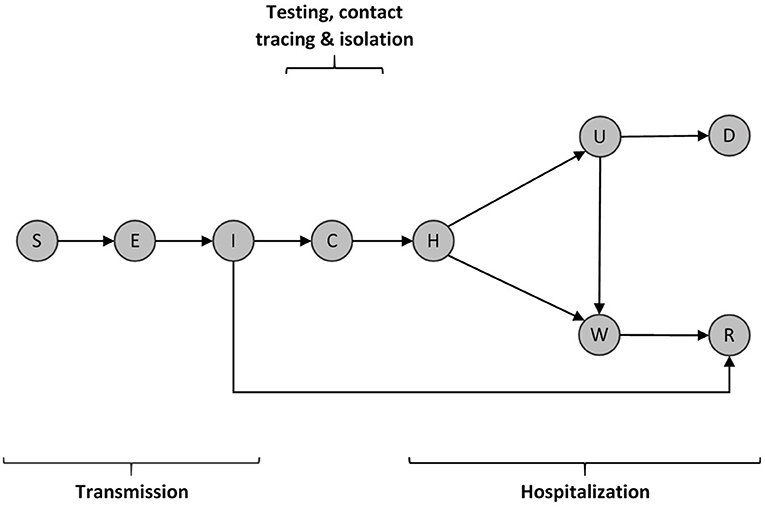
Figure 2. Schematic diagram of the COVID-19 transmission model. Individuals (S) susceptible to the virus become infected by infectious individuals (I). They then move through a latent period (E) before becoming infectious (I). Infectious individuals can either move through a detection period (C) or eventually recover without symptoms. Confirmed infectious individuals move through an initial hospitalization period (H) after which they are admitted to either an isolation ward (W) or an intensive care unit (U). Intensive care patients may recover and be sent to an isolation ward W or ultimately die (D). Isolated patients move through a recovery period (R), where they are assumed to be immune to the disease, at least in the medium term.
The progression through the different compartments in our model is characterized by key time periods which describe the dynamic transmission of infection, case detection, patient care and hospitalization, and recovery or death: the average durations of viral latency (1/σ), carrier infectiousness (1/γ), onset-to-hospitalization (1/α), onset-to-death, hospitalization-to-discharge, and ICU-stay. The fraction of individuals who end up being detected (f ) is related to the case fatality rate. Since the transmission rate β is affected by the implementation of control measures, we take it as a function of time β(t) = β0κ(t), where β0 is the transmission rate without control measures (baseline) and κ(t) is a positive scaling factor by which interventions may reduce the transmission rate. In other words, κ values smaller than 1 characterize a more effective intervention in curbing the epidemic. Here κ = 1 indicates an ineffective or absent control measure, with values greater implying improper control measures or non-compliance.
We remark here that the modeling was made possible despite the lack of population health data such as country demographics and associated person-person contact structure. Hence, we assumed homogeneous mixing not accounting for age-structure nor the risk associated with comorbidities. Nonetheless, these can be easily incorporated into our model once detailed data become available.
Data and Parameters
Numbers of confirmed infection and death cases were collected from daily reports from the European Center for Disease Control (18). All our data sources are outlined in Table 1. The key time durations in our model were fixed to values obtained from published datasets as well as unpublished local hospitalization data. The mean durations of latency, incubation and infectiousness of SARS-CoV-2 ware based on the reported cases from the COVID-19 outbreak in Singapore and Tianjin, China (20).
We assume that a single case started the outbreak on February 24th, 2020, which coincides with the date of the first reported case of COVID-19 in Kuwait. The total population of Kuwait (N) is about 4,776,000. We note here that our model parameter estimation is insensitive to the number of susceptible individuals as long as the number of cases is small relative to N. We take the initial unprotected susceptible population to be 500,000 which is the effective number of individuals who account for the majority of local community transmission in Kuwait. This estimate is consistent with the assumptions that (1) the majority of the population has been protected by the stay-at-home orders, (2) most community transmission cases are localized to certain geographic areas, and (3) children younger than 18 years old represent a very small percentage of the total number of infected patients. However, we also model 1,500,000 susceptible individuals and show the corresponding results.
To assess the impact of control interventions, we assume κ(t) = 1 prior to the implementation of a partial lockdown on March 22, 2020 (Figure 1). We then estimate κ and the baseline transmission rate β0 by employing a maximum likelihood framework (17). To derive the maximum likelihood estimates (MLE) of our unknown parameters we assume the daily numbers of incident infections are detected according to a negative binomial distribution (NBD). We additionally assume the daily number of incident deaths are drawn from a similar distribution. Then optimization was carried out using the Nelder-Mead method (22) on the combined minus log-likelihood function.
The uncertainty of parameters was represented by quantile-based credible intervals (CI). We use the asymptotic normality of MLE to account for such uncertainty through deriving simulation-based 95% CIs for the model curves (23). Simulations were run 10,000 times based on random draws of the unknown model parameters from a normal distribution . Here are maximum likelihood estimates and Σ is the variance-covariance matrix associated with them. Given the parameterization of our transmission model, these parameters permit a model-based estimation of the basic and effective reproduction numbers. In particular, in each simulation run an R0 value is drawn from a range of values (Table 1) as an initial point to kick start the parameter search algorithm. Our transmission model was fitted to estimate key transmission parameters. The maximum likelihood estimates of the baseline and effective transmission rates, β0 and βe were used compute the basic and effective reproduction numbers via these formulas
All simulations, parameter estimation and model calibration were run in the R software (24).
Results
Our estimated basic reproduction number is R0 = 1.43 (95% CI: 1.33–1.58). Interestingly, the MLE of the factor by which control measures reduce transmission was estimated at κ = 1 (95% CI: 0.9998–1). This corresponds to an effective reproduction number Re = R0, which is consistent with reports from the Center for Mathematical Modeling of Infectious Diseases (25).
We remark here that our model-based estimates of the reproduction numbers, which directly influence the prevalence of the epidemic, depend on the values we adopt for the incubation and infectious periods (Table 1). In particular, larger periods are expected to lead to higher values for the reproduction numbers. For example, we find Rt = R0 = 1.97 (95% CI: 1.85–2.12) if we change the incubation and infectious periods to 5 and 6 days, respectively.
Our parameter estimations captured the variation around the observed number of reported cases and deaths to project a posterior distribution of the expected numbers. Our projected trajectories and their 95% credible intervals were able to capture the early slow increase in observed cases, hospitalization and deaths (Figure 3).
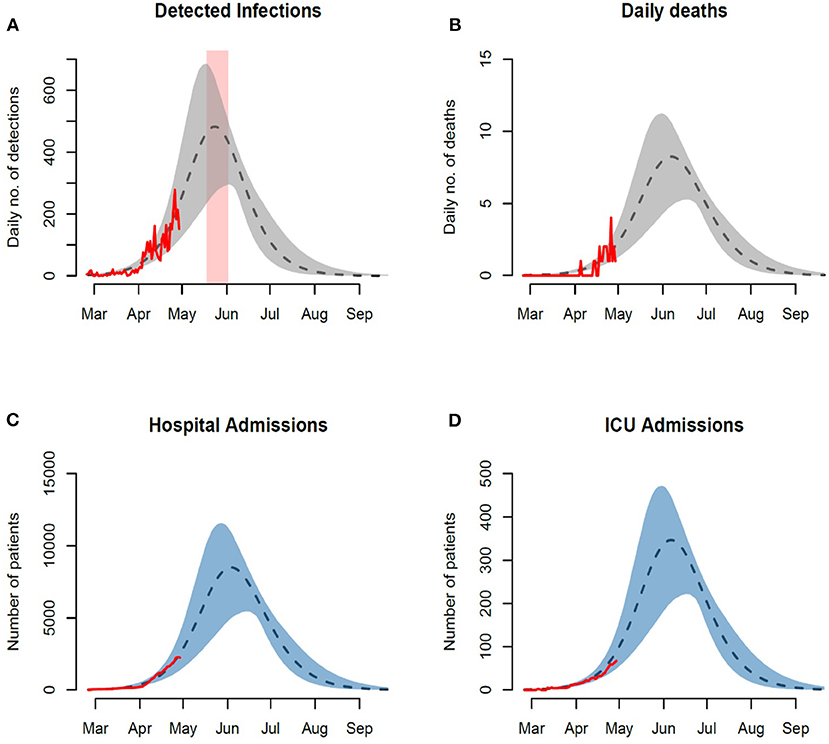
Figure 3. Observed and forecasted trajectories assuming 500,000 unprotected susceptible individuals. Observed and projected daily numbers of (A) incident infections, (B) death cases, (C) general hospital admissions, and (D) ICU admissions. Red rectangular ribbon highlights the projected time-window of the epidemic peak. Red lines represent the reported data. Black dashed lines represent model projections based on MLE of unknown parameters with shaded ribbons representing 95% credible interval on new observations. We note here that the observed cases and their projections only represent a fraction of the actual and model prevalence. This is based on our assumption of under-reporting and the presence of asymptomatic individuals in the population.
Under the current testing rate, capacity and scope, the model projects the daily numbers of reported cases to peak around 480 (95% CI: 300–680) by the second half of the month of May. In terms of the burden on the healthcare system, our model projects peak hospital admission of 8,000 patients (95% CI: 5,000–12,000) with ICUs projected to peak around 350 patients (95% CI: 220–480). At these rates the model projects a peak daily mortality around 8 deaths (95% CI: 5–12). We additionally explored a scenario that simulates an expansion in the size of the susceptible subpopulation by a factor of three (Figure 4). A summary of the projected epidemic and healthcare burdens is presented in Table 2.
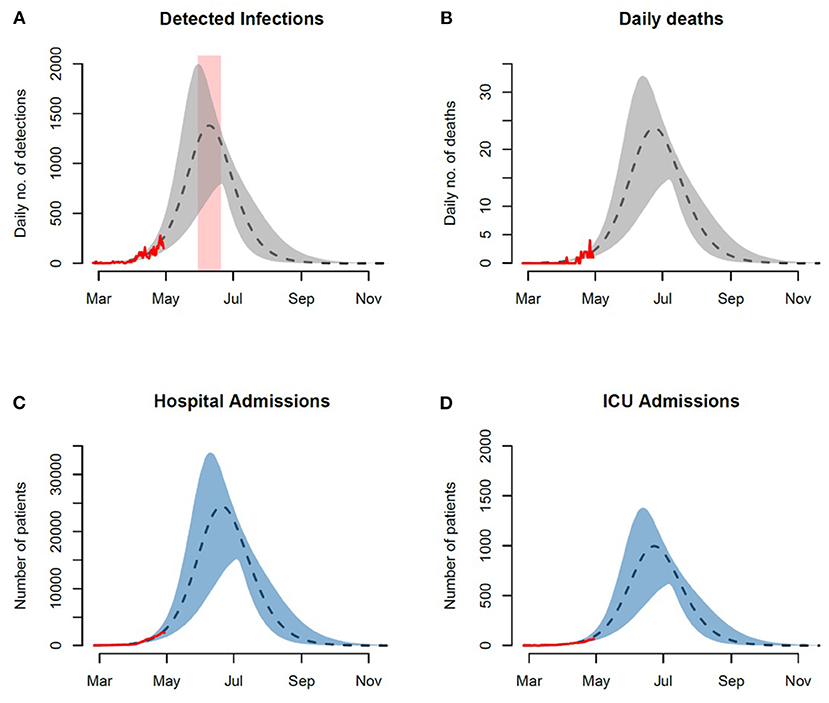
Figure 4. Tripling the size of the unprotected susceptible population. Peaks of forecasted trajectories are approximately tripled in size. The projected time-window of the peak is delayed by 2-weeks and widened (3-week period). Observed and projected daily numbers of (A) incident infections, (B) death cases, (C) general hospital admissions, and (D) ICU admissions. Red rectangular ribbon highlights the projected time-window of the epidemic peak. Red lines represent the reported data. Black dashed lines represent model projections based on MLE of unknown parameters with shaded ribbons representing 95% credible interval on new observations. We note here that the observed cases and their projections only represent a fraction of the actual and model prevalence. This is based on our assumption of under-reporting and the presence of asymptomatic individuals in the population.
Discussion
We developed a mathematical modeling framework for real-time tracking and forecasting of the epidemic outbreak of COVID19 in Kuwait and the associated burden on the healthcare system. This quantitative framework is further employed to evaluate how the control measures implemented in Kuwait may have influenced the epidemic burden. Such tools can derive important policymaking decisions. Insight from Kuwait can potentially inform similar policies, programs and public health measures taken by other developing countries.
Our results suggest that the early gradual and stringent control measures in Kuwait had the effect of delaying and lowering the intensity of the outbreak by protecting a large fraction of the population. Despite the fact that the country has been under lockdown since March 22nd, 2020, our model indicates that the effective reproduction number (Re) remained unchanged. In principle, such control measures are implemented to achieve a sufficient reduction in the effective reproduction number during an outbreak. This may be explained by the reported outbreaks amongst migrant workers (26). Kuwait has a considerably heterogenous population with 60% comprised of non-nationals. A large proportion of these workers cluster in certain areas and live in cramped dormitories with poor and unsanitary housing conditions (27). Strict social distancing measures may not be implementable nor have the same effect on these subpopulations. Hence, this could exacerbate the transmission of the infection in the presence of lockdowns. It is therefore imperative, for the epidemiological understanding of the disease distribution, to perform demographic studies that aim to extract contact structure matrices and establish how different control measures may or may not affect heterogenous transmission rates (28). This is not only applicable to the State of Kuwait, but also the Arabian Gulf states, Singapore and other countries with somewhat similar demographic profiles.
Additionally, our results indicate that the COVID-19 outbreak in Kuwait is on course to accelerate further in the next few weeks, which is consistent with the recent trends associated with expanded testing and contact tracing. Indeed, our model analysis of the projected epidemic trend indicates that hospitals may need to prepare for admitting around 12,000 patients of which 500 may need critical care.
This work has a number of limitations. First, we did not have detailed data on age structure, nor the risk associated with comorbidities. Younger individuals have lower risk of mortality and morbidity from COVID-19, while older people with comorbidities will have significantly higher case fatality ratio. If most of the recorded cases in Kuwait were young, then this might have led us to overestimate the results. In contrast, if the older or comorbid population was higher in Kuwait, we would be underestimating the results. The direction of the bias is critical when adopting this model. Secondly, many parameters were derived from unpublished data obtained from local hospitals in Kuwait. Although the parameters may change as the data are growing, we do not anticipate significant departure from the values presented in this work. Thirdly, we did not have demographic information. Careful consideration should be taken with regards to population heterogeneity, especially migrant workers. Further investigation with geospatial mapping to understand epidemic clusters is warranted. Finally, the complemented R code and real data from Kuwait should not be uncritically applied without careful tailoring to specific study settings and revisiting of the assumptions.
Conclusions
COVID-19 poses significant public health challenges to many developing countries including Kuwait. We have shown that stringent control measures can effectively delay and lower the intensity of the outbreak. However, they might not be sufficient to completely halt the transmission of the disease in the presence of certain structural restrictions pertaining to population and demographic factors. In turn, this highlights an urgent need for a systematic reassessment of public health interventions to account for demographic heterogeneities. Such an assessment needs to be supported by modeling tools to monitor the impact on the outbreak progression. In particular, our model can serve as a public health tool for decision makers to guide in the control of the current outbreak, even in the absence of critical population health data. This replicable tool can also be used to anticipate effective future measures should a second wave re-emerge in Kuwait and other developing countries. In addition, it can serve as a public health tool to track and control the current outbreak.
Data Availability Statement
The raw data supporting the conclusions of this article will be made available by the authors upon reasonable request.
Author Contributions
AA-S was involved in the conception and design of the study, analysis and interpretation of data, and drafting the article. HA was involved in acquisition, analysis and interpretation of data, and drafting the article. BA was involved in analysis and interpretation of data. FA-R was involved in interpretation of data. SA-S, MJ, and AA was involved in acquisition of data. QA-D was involved in was involved in revising the article critically for important intellectual content. FA-M was involved in analysis and interpretation of data and gave the final approval of the version to be submitted. All authors contributed to the article and approved the submitted version.
Conflict of Interest
The authors declare that the research was conducted in the absence of any commercial or financial relationships that could be construed as a potential conflict of interest.
Publisher's Note
All claims expressed in this article are solely those of the authors and do not necessarily represent those of their affiliated organizations, or those of the publisher, the editors and the reviewers. Any product that may be evaluated in this article, or claim that may be made by its manufacturer, is not guaranteed or endorsed by the publisher.
Acknowledgments
We would like to thank KFAS Emergency Resilience Program in Response to COVID-19 for their support. In addition, we thank Dr. Fatima Khadada from the Department of Medicine (University of Toronto) for her helpful comments on the manuscript, and Dr. Saud Alzaid from the Department of Surgery (Kuwait University) for his valuable input in the formulation of the ICU dynamics of the model.
References
1. Huang C, Wang Y, Li X, Ren L, Zhao J, Hu Y, et al. Clinical features of patients infected with 2019 novel coronavirus in Wuhan, China. Lancet. (2020) 395:497–506. doi: 10.1016/S0140-6736(20)30183-5
2. Wu F, Zhao S, Yu B, Chen YM, Wang W, Song ZG, et al. A new coronavirus associated with human respiratory disease in China. Nature. (2020) 579:265–9. doi: 10.1038/s41586-020-2008-3
3. Dong E, Du H, Gardner L. An interactive web-based dashboard to track COVID-19 in real time. Lancet Infect Dis. (2020) 20:533–4. doi: 10.1016/S1473-3099(20)30120-1
4. Alshukry A, Ali H, Ali Y, Al-Taweel T, Abu-Farha M, AbuBaker J, et al. Clinical characteristics of coronavirus disease 2019 (COVID-19) patients in Kuwait. PLoS ONE. (2020) 15:e0242768. doi: 10.1371/journal.pone.0242768
5. Legrand J, Grais RF, Boelle PY, Valleron AJ, Flahault A. Understanding the dynamics of Ebola epidemics. Epidemiol Infect. (2007) 135:610–21. doi: 10.1017/S0950268806007217
6. Kucharski AJ, Russell TW, Diamond C, Liu Y, Edmunds J, Funk S, et al. Early dynamics of transmission and control of COVID-19: a mathematical modelling study. Lancet Infect Dis. (2020) 20:553–8. doi: 10.1101/2020.01.31.20019901
7. Ferguson NM, Cummings DA, Cauchemez S, Fraser C, Riley S, Meeyai A, et al. Strategies for containing an emerging influenza pandemic in Southeast Asia. Nature. (2005) 437:209–14. doi: 10.1038/nature04017
8. Youssef HM, Alghamdi NA, Ezzat MA, El-Bary AA, Shawky AM. A new dynamical modeling SEIR with global analysis applied to the real data of spreading COVID-19 in Saudi Arabia. Math Biosci Eng. (2020) 17:7018–44. doi: 10.3934/mbe.2020362
9. Youssef H, Alghamdi N, Ezzat MA, El-Bary AA, Shawky AM. Study on the SEIQR model and applying the epidemiological rates of COVID-19 epidemic spread in Saudi Arabia. Infect Dis Model. (2021) 6:678–92. doi: 10.1016/j.idm.2021.04.005
10. Camacho A, Kucharski A, Aki-Sawyerr Y, White MA, Flasche S, Baguelin M, et al. Temporal Changes in Ebola Transmission in Sierra Leone and Implications for Control Requirements: a Real-time Modelling Study. PLoS Curr. (2015). 7. doi: 10.1371/currents.outbreaks.406ae55e83ec0b5193e30856b9235ed2
11. Funk S, Ciglenecki I, Tiffany A, Gignoux E, Camacho A, Eggo RM, et al. The impact of control strategies and behavioural changes on the elimination of Ebola from Lofa County, Liberia. Philos Trans R Soc Lond B Biol Sci. (2017) 372:20160302. doi: 10.1098/rstb.2016.0302
12. Riley S, Fraser C, Donnelly CA, Ghani AC, Abu-Raddad LJ, Hedley AJ, et al. Transmission dynamics of the etiological agent of SARS in Hong Kong: impact of public health interventions. Science. (2003) 300:1961–6. doi: 10.1126/science.1086478
13. Viboud C, Sun K, Gaffey R, Ajelli M, Fumanelli L, Merler S, et al. The RAPIDD ebola forecasting challenge: synthesis and lessons learnt. Epidemics. (2018) 22:13–21. doi: 10.1016/j.epidem.2017.08.002
14. Kucharski AJ, Camacho A, Checchi F, Waldman R, Grais RF, Cabrol JC, et al. Evaluation of the benefits and risks of introducing Ebola community care centers, Sierra Leone. Emerg Infect Dis. (2015) 21:393–9. doi: 10.3201/eid2103.141892
15. Russell TW, Hellewell J, Jarvis CI, van Zandvoort K, Abbott S, Ratnayake R, et al. Estimating the infection and case fatality ratio for coronavirus disease (COVID-19) using age-adjusted data from the outbreak on the Diamond Princess cruise ship, February 2020. Euro Surveill. (2020) 25:256. doi: 10.2807/1560-7917.ES.2020.25.12.2000256
16. Althaus CL, Low N, Musa EO, Shuaib F, Gsteiger S. Ebola virus disease outbreak in Nigeria: Transmission dynamics and rapid control. Epidemics. (2015) 11:80–4. doi: 10.1016/j.epidem.2015.03.001
18. The Geographic Distribution of COVID-19 Cases Worldwide. (2020). Available online at: https://www.ecdc.europa.eu (accessed May 3, 2020).
19. Ferguson N, Laydon D, Nedjati Gilani G, Imai N, Ainslie K, Baguelin M, et al. Report 9: Impact of Non-pharmaceutical Interventions (NPIs) to Reduce COVID19 Mortality and Healthcare Demand. Faculty of Medicine, School of Public Health, Imperial College London COVID-19 2020 (2020).
20. Ganyani T, Kremer C, Chen D, Torneri A, Faes C, Wallinga J, et al. Estimating the generation interval for coronavirus disease (COVID-19) based on symptom onset data. Euro Surveill. (2020) 25:2000257. doi: 10.2807/1560-7917.ES.2020.25.17.2000257
21. Anderson SC, Edwards AM, Yerlanov M, Mulberry N, Stockdale JE, Iyaniwura SA, et al. Quantifying the impact of COVID-19 control measures using a Bayesian model of physical distancing. PLoS Comput Biol. (2020) 16:e1008274. doi: 10.1371/journal.pcbi.1008274
22. Nelder JA, Mead R. A simplex method for function minimization. Comp J. (1965) 7:308–13. doi: 10.1093/comjnl/7.4.308
23. Mandel M. Simulation-based confidence intervals for functions with complicated derivatives. Am Stat. (2013) 67:76–81. doi: 10.1080/00031305.2013.783880
24. R Development Core Team. R: A Language and Environment for Statistical Computing. Vienna: Austria R Foundation for Statistical Computing (2014).
25. Abbott S, Hellewell J, Thompson RN, Sherratt K, Gibbs HP, Bosse NI, et al. Estimating the time-varying reproduction number of SARS-CoV-2 using national and subnational case counts. Wellcome Open Res. (2020) 5:112. doi: 10.12688/wellcomeopenres.16006.2
26. Ali H, Alshukry A, Marafie SK, AlRukhayes M, Ali Y, Abbas MB, et al. Outcomes of COVID-19: Disparities by ethnicity. Infect Genet Evol. (2021) 87:104639. doi: 10.1016/j.meegid.2020.104639
27. Alahmad B, Kurdi H, Colonna K, Gasana J, Agnew J, Fox MA. COVID-19 stressors on migrant workers in Kuwait: cumulative risk considerations. BMJ Glob Health. (2020) 5:e002995. doi: 10.1136/bmjgh-2020-002995
Keywords: COVID-19, public health, mathematical modeling, forecasting, healthcare demand, epidemic outbreak, infectious disease
Citation: Al-Shammari AA, Ali H, Alahmad B, Al-Refaei FH, Al-Sabah S, Jamal MH, Alshukry A, Al-Duwairi Q and Al-Mulla F (2021) The Impact of Strict Public Health Measures on COVID-19 Transmission in Developing Countries: The Case of Kuwait. Front. Public Health 9:757419. doi: 10.3389/fpubh.2021.757419
Received: 12 August 2021; Accepted: 25 October 2021;
Published: 22 November 2021.
Edited by:
Noor Hazilah Abd Manaf, International Islamic University Malaysia, MalaysiaReviewed by:
Nick Petford, University of Northampton, United KingdomAlaa Abdelbary, Arab Academy for Science, Technology and Maritime Transport (AASTMT), Egypt
Copyright © 2021 Al-Shammari, Ali, Alahmad, Al-Refaei, Al-Sabah, Jamal, Alshukry, Al-Duwairi and Al-Mulla. This is an open-access article distributed under the terms of the Creative Commons Attribution License (CC BY). The use, distribution or reproduction in other forums is permitted, provided the original author(s) and the copyright owner(s) are credited and that the original publication in this journal is cited, in accordance with accepted academic practice. No use, distribution or reproduction is permitted which does not comply with these terms.
*Correspondence: Abdullah A. Al-Shammari, YWJkdWxsYWguYWxzaGFtbWFyaUBrdS5lZHUua3c=
 Abdullah A. Al-Shammari
Abdullah A. Al-Shammari Hamad Ali
Hamad Ali Barrak Alahmad
Barrak Alahmad Faisal H. Al-Refaei2
Faisal H. Al-Refaei2 Salman Al-Sabah
Salman Al-Sabah Mohammad H. Jamal
Mohammad H. Jamal Fahd Al-Mulla
Fahd Al-Mulla